During the pandemic, we decided to plant a forest border along our roadside boundary, experimenting with a technique we’ve not used before called the Miyawaki method.
The micro-forest planted will grow over the next 10 years and provide a ‘green screen’ for the creatures, plants and people that spend time at the Horniman.
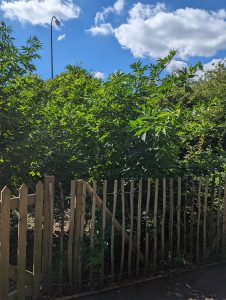
The lush-looking London Road Forest Border in August 2023
What is the Miyawaki method?
Developed by Japanese botanist Akira Miyawaki, the technique encourages rapid, strong forest growth with a bit of healthy competition. Using varieties native to the environment, saplings are planted close together in the ground.
Such overcrowding encourages the trees to battle over light, space and water, therefore mimicking natural forestation processes. If all goes to plan, the trees will grow taller, stronger and faster than other man-made forests.
How was this technique developed?
Mr Miyawaki (29 January 1928-16 July 2021) had a particular interest in phytosociology, which is how plant species interact with one another in shared environments. After completing a PhD in plant ecology, Mr Miyawaki studied under specialist Reinhold Tüxen in Germany. There he learned about the concept of potential natural vegetation.
This is an idea that suggests that, to improve biodiversity, gardeners must create an environment similar to that of pre-human involvement in landscapes.
Taking this idea further, Mr Miyawaki noted that indigenous, or naturally occurring, forests are layered together with four categories of plants. These include main tree layer species, sub-tree species, shrubs and ground-covering herbs. By combining all he had learned, Mr Miyawaki developed a new way of planting forests.
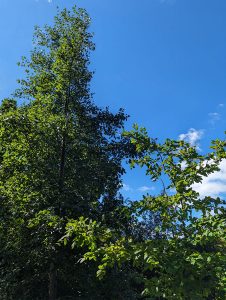
The Forest Border has been growing very well this year
Why use the Miyawaki method?
Unlike traditional planting methods, trees grown using the Miyawaki technique grow very rapidly.
This makes the planting structure ideal for smaller projects and those implemented in urban environments, such as our Forest Border.
All woodlands capture carbon from the atmosphere and encourage biodiversity. But studies have shown that a Miyawaki forest is home to a greater variety of living organisms, including animals, birds and insects, than traditionally planted woodlands.
The denseness of growth typical in a Miyawaki forest is thought to provide more opportunity for pollinators and shelter for birds. Increased canopy cover shades out weeds and creates a cool climate for insects. Greater volumes of deadwood and leaf litter build fertility in the soil, ideal for fungi and invertebrates, while a wide variety of species is thought to be better insulated from disease destruction.
Given the climate and ecological emergency, which has seen global animal species decline, planting techniques which encourage biodiversity are more important now than ever before.
The Horniman’s micro-forest is getting on for two years old, having been planted in January 2022. This summer it is looking leafier and more verdant than ever before. The Horniman’s Supervising Horticulturalist, Annette Foerger, told us about the forest progress from the beginning of last year.
“In the first three years, the most important thing is weed management. We tackled this by covering the ground with a special straw-like mulch, similar to that used in vegetable gardens, to suppress weeds. And it has worked.
“We topped up the mulch this spring and we think now it is one of the reasons the trees have grown so well. The trees are in competition with one another rather than being in competition with the weeds as well.
“The plants seem to have grown in a textbook Miyawaki fashion. The trees we planted are mostly growing tall and narrow and won’t develop a crown like they might in more traditional settings. When planting, we included a mix of species that grow at different rates, including pioneer fast-growing plants such as silver birch, which can provide protection for slower-growing varieties such as oak and beech trees.
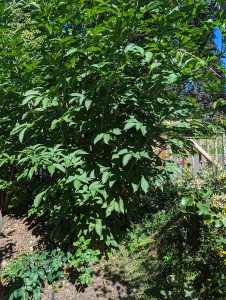
This elder bush has grown enormous very quickly, while the oak sapling beneath it is still very small
“What has been interesting to observe is, within a relatively small area – the Forest Border spans 400 square metres – there are different microclimates and soil conditions within it. Some patches have much wetter soil, due to the topography of the area, and that’s where the areas of most explosive growth have been.
“We have had a few losses over the last 18 months. Initially, around 900 trees were planted. We have seen fewer than 50 losses over the period. We do expect to see that number rise a little over the next few years, particularly if we have another extremely dry summer similar to last year.
“But mostly, we have let nature do its thing.”
The plants seem to have grown in a textbook Miyawaki fashion.
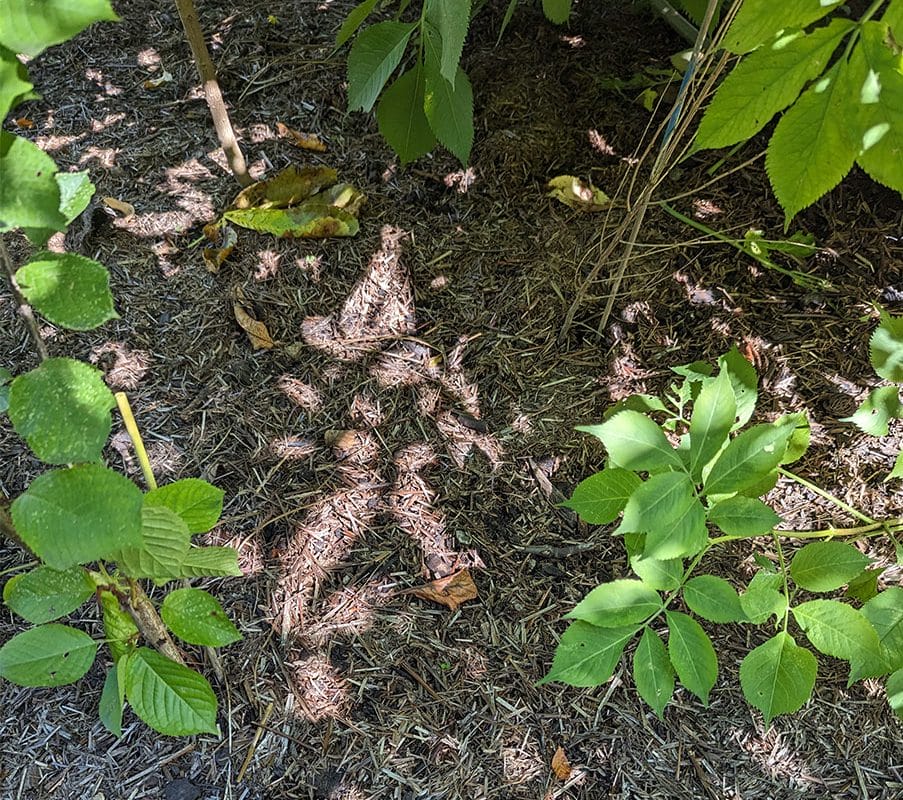
Early on in the project, we asked our Head of Horticulture Errol Reuben Fernandes what he hoped for the forest’s future. ‘In 10 years we can expect to see a dense thicket of trees three metres high that will screen our view of the busy South Circular road. A micro-forest will absorb 30 times more CO2 than conventional tree planting and the dense canopy will act as a particulate pollution filter.’
We can’t wait to see it.
A micro-forest will absorb 30 times more CO2 than conventional tree planting.
What are the benefits of a Miyawaki forest?
At the Horniman, we’re hoping that the Forest Border will absorb light, sound and air pollution, shielding the gardens from the worst of the road traffic. In fact, the trees are particularly good at capturing particulate pollution and CO2.
The increased vegetation will help to regulate the temperature of the surrounding Gardens, while the forest will improve the soil quality and reduce the risk of erosion and flooding.
How can you make your own micro-forest?
If you are lucky enough to have the time and space to try creating your own micro-forest, there are a few steps to follow.
Step one – consider a location
To plant a successful Miyawaki forest, the minimum space requirement is a plot of three metres by four metres. Luckily, the technique is not restricted by soil conditions or climate, but it will need an area which remains sunny for at least eight hours a day.
Once the ideal location has been selected, the ground must be cleared. You can add a mound or two for interest if you like.
Step two – prepare the soil
Once you have cleared the area, prepare the soil with locally available compost. If you make your own, like we do in the Gardens, even better.
You can also mix organic fertilisers and water retainers, which are usually widely available, into the soil if you wish.
Step three – picking your plants
The trick to the Miyawaki method is to embed as many different plants as possible into the area. Ideally, pick native trees and shrubs, using a mixture of main tree layer species, sub-tree species, shrubs and ground-covering herbs.
At the Horniman Gardens, we have planted a mixture of these trees in the Forest Border:
- Euonymus oxyphyllus
- Clerodendrum trichotomum
- Ginkgo biloba
- Larix decidua
- Prunus cerasifera
- Amelanchier lamarckii
- Cornus mas
- Hippophae salicifolia
- Sorbus torminalis
- Sorbus aria
- Quercus petraea
- Pinus sylvestris
We asked our Head of Horticulture, Errol, how he selected the plant species to grow. ‘With climate change in mind and the climate in London predicted to be similar to that of Barcelona by 2050, we also included species from further afield. These trees have been selected for their ability to withstand a reduction in rainfall and an increase in temperatures.’
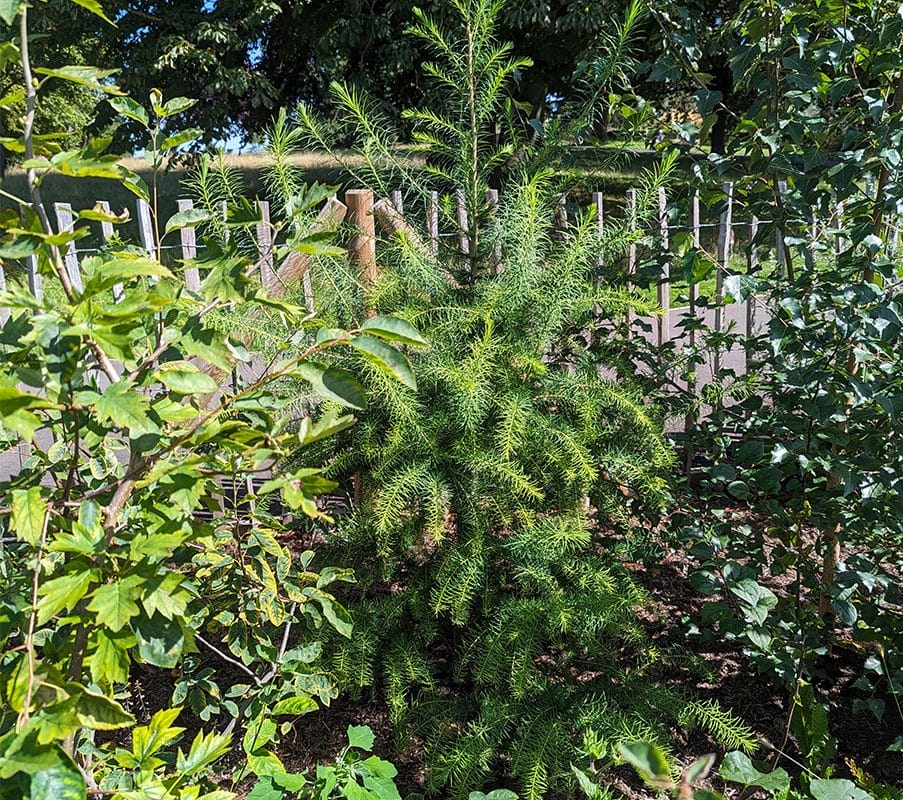
Step four – arranging the plants
Arrange dense planting. You’re aiming for a random structure, with similar species spread out while avoiding a repeated pattern. As a general rule of thumb, try to plant three to five saplings per square metre.
Remember to plant the seedlings close together. It might seem unnecessary, but this denseness forces the plants to compete and therefore grow quickly. Miyawaki forests can be up to 30 times denser than traditionally planted woodlands.
When the planting is complete, spread a thick layer of mulch over the soil.
Will you have a go at creating your own mini-forest? Send us your pictures if you do, using #Horniman.
The London Road Forest Border has been made possible by generous donations from our brilliant community as part of the London Road Planting Appeal, and the Kusuma Trust.
Find out more about our progress in climate and ecological work in the Climate and Ecology Manifesto – two years on.


